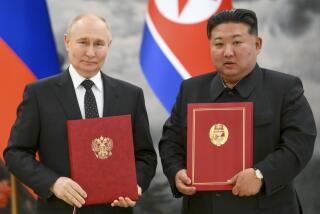How to Halt the Northâs Missile Test
North Korea is about to test a new missile to blackmail the United States into aiding its failing economy, or so the prevailing orthodoxy goes. That orthodoxy is dangerously wrong.
Instead, North Korea has been trying to improve relations with the United States by mutual accommodation, but the U.S. has been unwilling to reciprocate. It has not even kept the promise to ease sanctions that it made in the October 1994 Agreed Framework, the deal that froze North Koreaâs nuclear program. That is why the North is now threatening to test a missile. It is playing tit-for-tat, not blackmail.
North Korea says it is willing to negotiate an end to its missile exports and development. In return, it wants the United States to end the economic embargo it imposed during the Korean War and to normalize relations. Pyongyang also seeks aid and investment from the West, but its main aim is not economic. It is political.
Last Mayâs visit to Pyongyang by William Perry, former secretary of Defense, has opened the way to a deal that could bring an end to North Korean missile testing and mark the start of reconciliation between former foes, but only if we keep our end of the nuclear bargain by relaxing sanctions. There is significant evidence that Pyongyang wants a missile deal, and has since 1992.
If North Korea was determined to develop, deploy and export longer-range ballistic missiles, as some believe, it should have been testing its No Dong, Taepodong 1 and Taepodong 2 missiles for several years. Yet the North did not conduct any tests from May 1993 until August 1998. That suggests that North Korea is restraining itself in the hopes of concluding a missile deal with the U.S.
If North Korea wants engagement with the United States, why does it dig holes and test missiles? Unfortunately, Pyongyang has learned that threats are the only way to get Washington to negotiate in earnest--a lesson Washington keeps reinforcing by its own inaction, absent such threats.
In Pyongyangâs view, Washington was reluctant to move beyond the 1994 accord to greater political and economic engagement. Pyongyang reasoned that if Washington was willing to supply nuclear reactors, improved diplomatic, trade and other ties should have followed. Even worse, from Pyongyangâs point of view, Washington has been unwilling to live up to its end of the nuclear bargain. The Clinton administration initially understated the cost of the heavy fuel oil that it pledged to provide under the accord. It was slow to seek additional funding and Congress was slow to provide it. Fuel deliveries fell behind at the end of 1997. Moreover, construction of the first of two light-water reactors to replace the reactors to be dismantled is many months behind.
The United States is now offering to end sanctions, but it has yet to take the modest steps that the North was long led to expect: unfreezing assets seized in the Korean War, allowing commercial loans from American banks and licensing private investment projects in mining and agriculture. North Korea, believing it was adhering to the letter of the framework and not getting much in return, began warning in January 1998 that it might abandon the accord unless Washington went ahead with implementation. In late April 1998, the North stopped canning plutonium-laden spent fuel at Yongbyon, but only after all the 8,000 or so intact fuel rods were put in casks and nothing but nuclear sludge from a few disintegrating rods remained. On May 7, 1998, Pyongyang said it would need to âopen and adjustâ its reactor for maintenance, in the presence of international inspectors. And it renewed digging at an underground site at Kumchangri that had been under U.S. scrutiny since 1988.
Yet threats to break the 1994 Agreed Framework are not the same as breaking it. As the visit by U.S. inspectors to the suspect site at Kumchangri showed, North Korea has been punctilious in observing the nuclear accord.
Pyongyangâs test of the Taepodong 1 last August and its threat to resume tests now are designed to get Washington to negotiate. North Koreaâs expressed interest in a missile deal is a sign of its larger purpose: to end its enmity with the United States. U.S. economic sanctions, dating from the Korean War, are a monument to that enmity. Ending the sanctions would improve the political climate for a far-reaching deal to defuse the armed confrontation in Korea. Without meaningful political and economic engagement, the North is unlikely to agree to meaningful military disengagement.
How can Pyongyang be expected to end its artillery threat to Seoul while the United Statesâ Trading with the Enemy Act remains in force?
More to Read
Sign up for Essential California
The most important California stories and recommendations in your inbox every morning.
You may occasionally receive promotional content from the Los Angeles Times.










